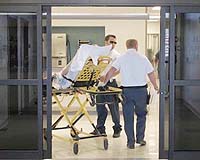 |
Granada, Spain (SPX) Apr 29, 2010 Scientists from the University of Granada, Spain, have generated artificial human skin by tissular engineering basing on agarose-fibrin biomaterial. The artificial skin was grafted onto mice, and optimal development, maturation and functionality results were obtained. This pioneering finding will allow the clinical use of human skin and its use in many laboratory tests on biological tissues -which, additionally, would avoid the use of laboratory animals. Further, this finding could be useful in developing new treatment approaches for dermatological pathologies. This research was conducted by Jose Mar�a Jimenez Rodr�guez, from the Tissular Engineering Research group of the Department of Histology of the University of Granada, and coordinated by professors Miguel Alaminos Mingorance, Antonio Campos Munoz and Jose Miguel Labrador Molina. Researchers from the University of Granada firstly selected the cells that would be employed in generating artificial skin. Then, they analysed the evolution of the in-vitro culture and, finally, they performed a quality control of the tissues grafted onto nude mice. To this purpose, several inmunofluorescence microscopy techniques had to be developed. These techniques allowed researchers to evaluate such factors as cell proliferation, the presence of differentiating morphological markers, the expression of cytokeratin, involucrine and filaggrin, angiogenesis and artificial skin development into the recipient organism.
Human Skin Samples To create artificial human skin, human fibrin from plasma of healthy donors was used. Researchers then added tranexamic acid -to prevent fibrinolysis-, and calcium chloride to precipitate fibrin coagulation, and 0.1% aragose. These artificial-skin substitutes were grafted on the back of the nude mice, with the purpose of observing its evolution in vivo. The equivalent skin substitutes were analysed by transmission and scanning light and electron microscopy and inmunofluorescence. The skin created in the laboratory showed adequate biocompatibility rates with the recipient and no rejection, dehiscence or infection was registered. Additionally, the skin of all animals used in the study started to show granulation after six days from implantation. Within the following twenty days, cicatrization was complete. The experiment conducted by the University of Granada is the first to create artificial human skin with a dermis made of fibrin-agarose biomaterial. To this date, artificial skin substitutes were elaborated with other biomaterials as collagen, fibrin, polyglycolic acid, chitosan, etc. These biomaterials "added resistance, firmness and elasticity to the skin" -according to Prof. Jimenez Rodr�guez. "Definitively, we have created a more stable skin with similar functionality to normal human skin."
Share This Article With Planet Earth
Related Links University of Granada Hospital and Medical News at InternDaily.com
 Death Rates Not Best Judge Of Hospital Quality
Death Rates Not Best Judge Of Hospital QualityBaltimore MD (SPX) Apr 21, 2010 Inpatient mortality rates, used by organizations to issue "report cards" on the quality of individual U.S. hospitals, are a poor gauge of how well hospitals actually perform and should be abandoned in favor of measures that more accurately assess patient harms and the care being provided, argue patient safety experts in a new paper. Peter Pronovost, M.D., Ph.D., professor of anesthesiology ... read more |
|
| The content herein, unless otherwise known to be public domain, are Copyright 1995-2010 - SpaceDaily. AFP and UPI Wire Stories are copyright Agence France-Presse and United Press International. ESA Portal Reports are copyright European Space Agency. All NASA sourced material is public domain. Additional copyrights may apply in whole or part to other bona fide parties. Advertising does not imply endorsement,agreement or approval of any opinions, statements or information provided by SpaceDaily on any Web page published or hosted by SpaceDaily. Privacy Statement |